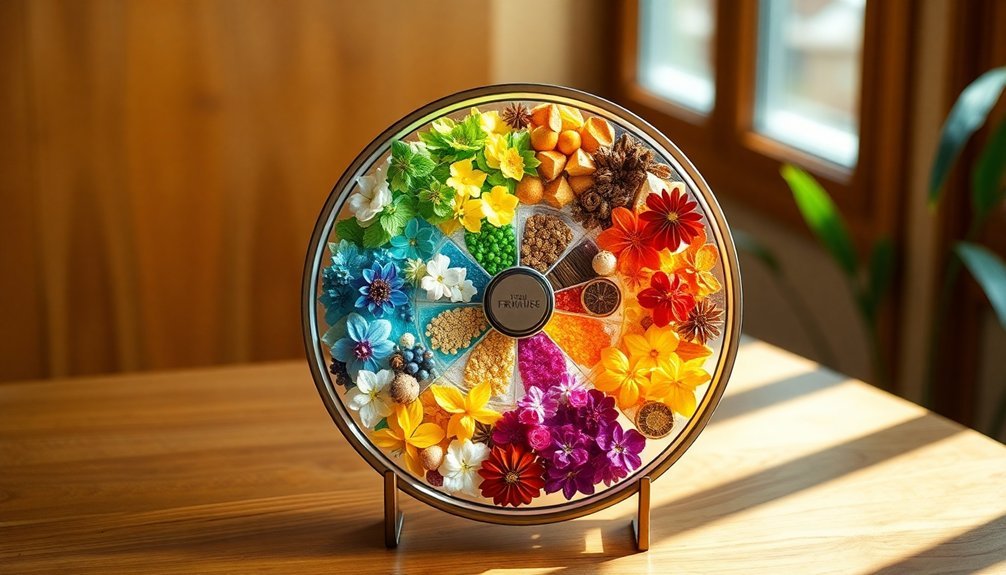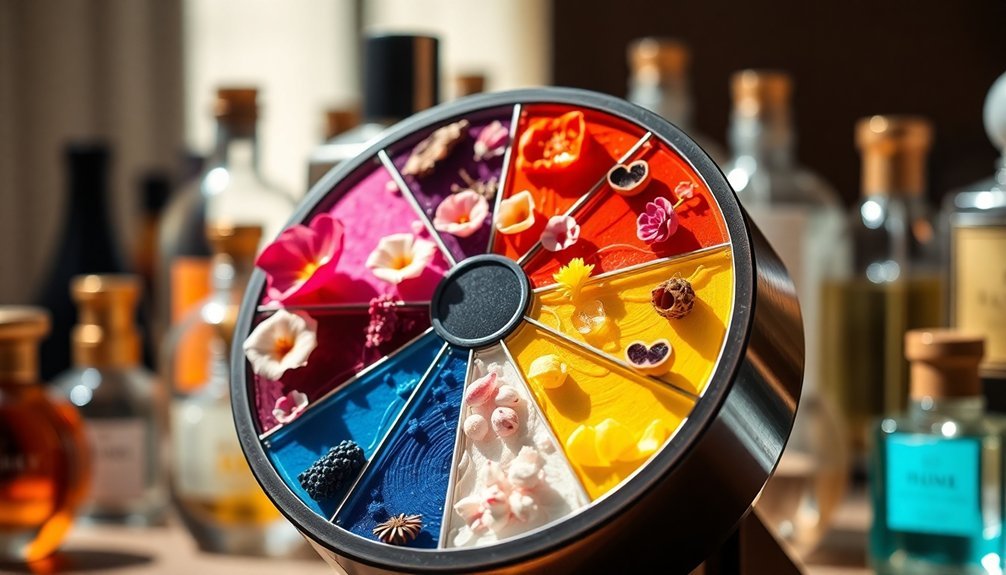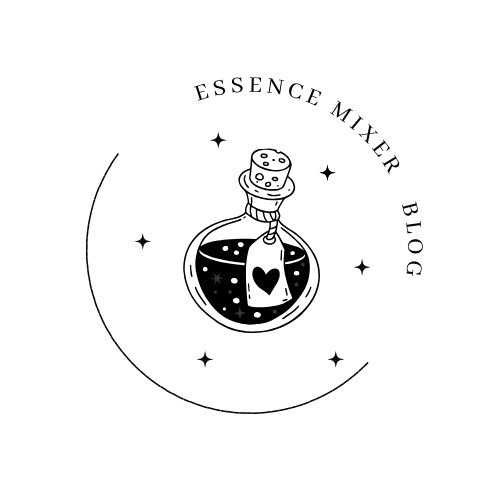Discover the perfume wheel through 5 simple steps: First, familiarize yourself with the four main scent families – floral, amber, woody, and fresh. Then, identify specific notes within each category, from delicate jasmine to rich sandalwood. Next, explore complementary combinations across the wheel. Fourth, understand fragrance concentrations and their longevity. Finally, develop your personal scent profile by experimenting with different subfamilies. The journey to becoming a fragrance expert reveals endless aromatic possibilities.
The Four Main Scent Families Explained

Perfume classification begins with four distinct scent families that serve as cornerstones of fragrance creation: Floral, Amber (Oriental), Woody, and Fresh.
When you're exploring these scent families, you'll find that Floral fragrances capture the essence of blooming flowers, featuring notes like rose and jasmine, with variations including floral oriental blends.
Amber scents offer warm, exotic profiles with rich spices and resins, often incorporating vanilla and myrrh.
You'll recognize Woody fragrances by their earthy character, typically featuring sandalwood and patchouli notes that create depth and sophistication.
The Fresh family delivers invigorating aromatic experiences through citrus, green, and aquatic notes, providing clean and bright sensations.
Each family creates unique olfactory experiences that you can combine to discover your perfect signature scent.
Identifying Notes Within Each Fragrance Category
Each fragrance family contains distinct aromatic signatures that you'll learn to recognize with practice.
When exploring floral scent profiles, you'll discover the delicate notes of jasmine, rose, and orange blossom that create a feminine character.
In woody notes, you'll encounter rich elements like sandalwood and patchouli that provide depth and sophistication.
Amber fragrances will captivate you with their warm vanilla and exotic spices, while fresh fragrances invigorate your senses with citrus and aquatic elements.
Each scent family includes specific components that appear as top notes, middle notes, and base notes.
As you explore the notes of a fragrance, you'll notice how they evolve, with fresh elements typically appearing first, followed by florals, and finally settling into deeper woody or amber foundations.
Mastering Fragrance Combinations and Pairings

While understanding individual fragrance families forms the foundation of perfumery, mastering the art of combining scents opens up endless creative possibilities.
The fragrance wheel helps you create harmonious blends by following three key techniques. You'll find kindred notes by exploring adjacent subfamilies, like pairing similar scent families such as floral with fresh notes. For unexpected yet balanced combinations, try the opposite technique by matching scents across the wheel – woody with floral, or amber with fresh.
The triangle technique offers another creative approach, where you'll select three subfamilies forming a triangle on the wheel. This method guarantees well-rounded fragrance combinations that maintain balance while expressing complexity.
You can experiment with complementary notes from different families to develop unique signature blends that reflect your personal style.
Understanding Scent Strength and Longevity
Beyond mastering fragrance combinations, understanding scent strength and duration helps you make informed choices about your preferred perfumes.
When you're selecting a fragrance, consider the concentration of fragrance oil, which directly impacts longevity and intensity.
Eau de Parfum offers the strongest scent, with 10-20% concentration and up to 8 hours of wear.
You'll find Eau de Toilette provides a balanced option, lasting 4-7 hours with 5-15% fragrance oil.
For a lighter touch, Eau de Cologne delivers a rejuvenating burst of scent that lingers for 2-3 hours.
If you're seeking a subtle fragrance, try Eau Fraiche with its minimal 1-2% concentration.
Creating Your Personal Fragrance Profile

Once you understand the basics of fragrance families, creating your personal fragrance profile becomes an exciting journey of self-expression.
Begin by exploring the four main scent families: Floral, Amber, Woody, and Fresh. Pay attention to which category naturally draws you in and reflects your personality.
Next, dive deeper into the subfamilies within your preferred scent family. If you're drawn to Amber, for instance, explore its various interpretations and discover how different notes combine to create unique compositions.
Use the fragrance wheel as your guide to find complementary scents that'll enhance your fragrance experience. Don't be afraid to experiment with layering different fragrances from adjacent subfamilies to create your signature scent.
Finally, consider fragrance strength to guarantee your chosen scents deliver the perfect balance of intensity and longevity throughout your day.
Frequently Asked Questions
How Do You Use Perfume Step by Step?
Choose your favorite scent family, test it on your skin at pulse points, let it settle for a few minutes, and layer complementary fragrances if you'd like. Don't forget wrists, neck, and ears.
What Is the 30 50 20 Rule for Perfume?
You'll find the 30-50-20 rule guides perfume composition: 30% top notes for first impressions, 50% middle notes for the fragrance's core character, and 20% base notes for lasting depth and foundation.
What Is the Fragrance Wheel Theory?
You'll find the fragrance wheel's a classification system that organizes scents into four main families: Floral, Amber, Woody, and Fresh. It helps you understand how different perfume notes relate and blend together.
How Do Perfume Rollers Work?
You'll roll the applicator on your skin, where a small ball rotates to release perfume oil. The roller design lets you apply fragrance precisely and portably, while the ball controls how much scent comes out.
In Summary
Now that you've learned to navigate the perfume wheel, you're equipped to explore fragrances with confidence. Understanding the four main scent families, their notes, and how they interact lets you make informed choices about your signature scent. Remember to take into account fragrance strength and longevity when selecting perfumes, and don't be afraid to experiment with different combinations to discover what truly speaks to your personality.





Leave a Reply